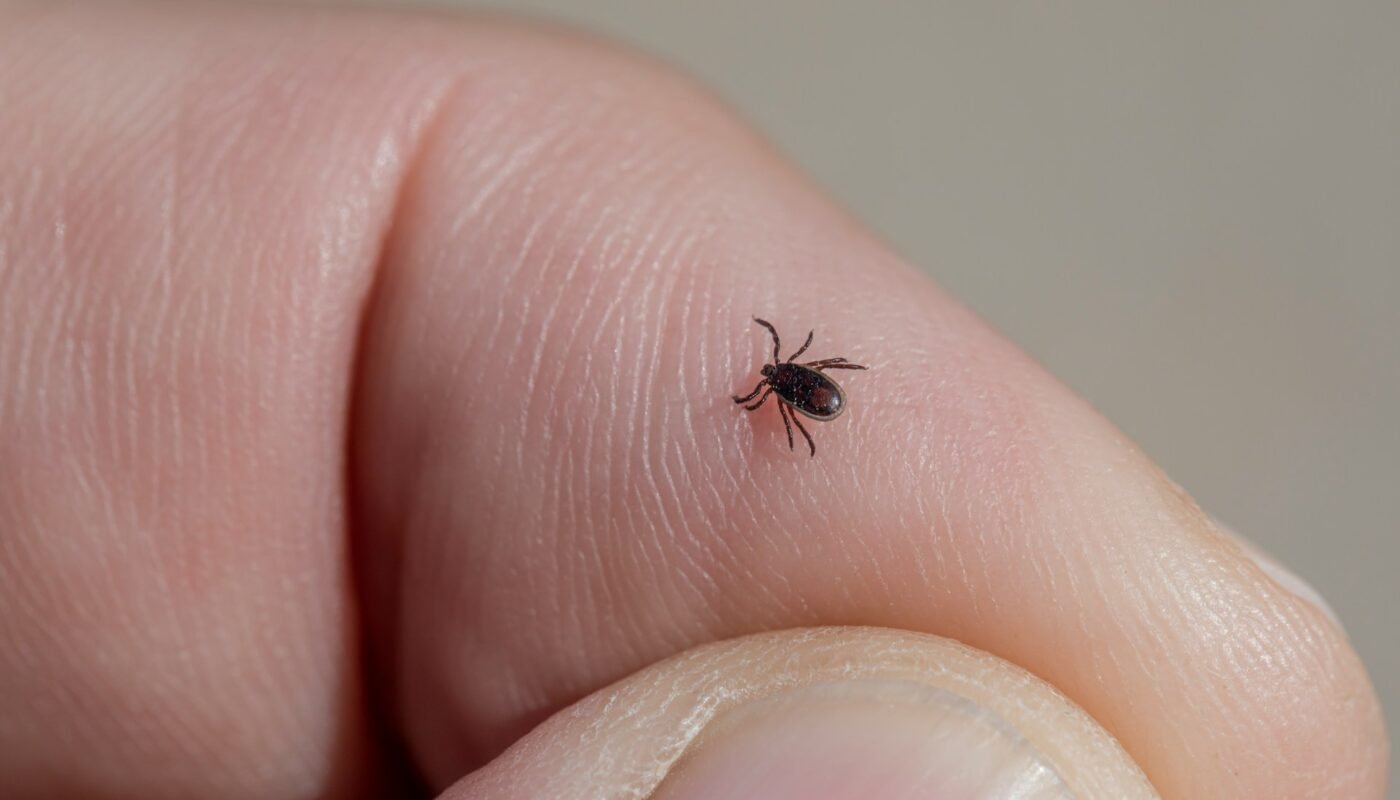Ticks are a growing threat in the Northwoods and lake country of Michigan, Wisconsin, and Minnesota. These parasites transmit serious diseases like Lyme disease, anaplasmosis, and babesiosis—illnesses now reported in nearly every county across all three states. Tick populations are rising due to milder winters, expanding deer herds, and increased woodland development.
If your cabin or cottage is surrounded by trees, tall grass, or near a lake, your risk of exposure is even greater. In popular cabin areas such as Michigan’s Upper Peninsula, Wisconsin’s Driftless Region, and Minnesota’s Brainerd Lakes, homeowners are seeing more tick activity earlier in the year.
This guide explains how to get rid of ticks around your cottage using clear, practical steps. From yard management to repellents and pet care, each action can help reduce exposure and make your property safer throughout the warm season.
Table of Contents
What Kind of Ticks Are Out There – Understand the Threat

Ticks thrive in shaded, humid environments. They are typically found in leaf litter, overgrown grass, brush lines, and forest edges. In the Great Lakes region, tick season starts as early as April and lasts through October, with peak activity in late spring and early summer.
Common tick species in the region include:
- Blacklegged ticks (deer ticks): Found across all three states and known carriers of Lyme disease, anaplasmosis, and babesiosis.
- American dog ticks: Widespread and often found near hiking trails, woodpiles, and sunny grassy areas. These ticks can carry Rocky Mountain spotted fever.
- Lone star ticks: Once rare, these aggressive ticks are expanding north into southern Michigan and Wisconsin. They’ve been linked to tick-borne meat allergies and other illnesses.
State health officials are tracking increasing infection rates. The Wisconsin Department of Health Services reports that Lyme disease cases have more than tripled over the past two decades. The Minnesota Department of Health has identified nearly all counties as high-risk zones. Michigan’s Lower Peninsula and Upper Peninsula have also seen a surge in blacklegged tick activity, according to the CDC.
Landscape Management
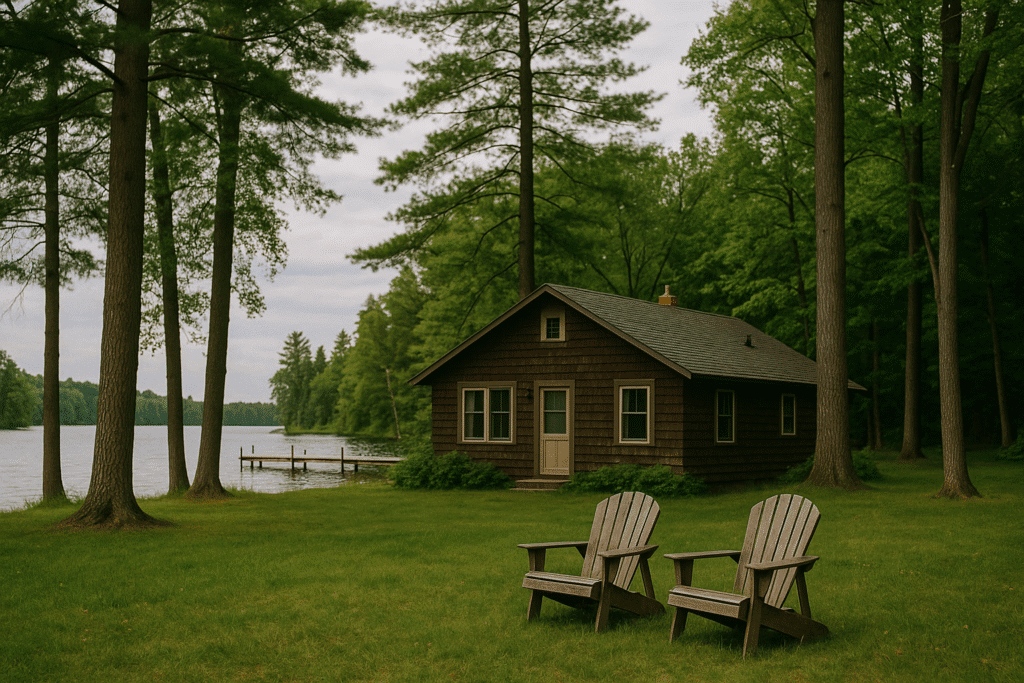
Reducing tick habitat around your cottage is one of the most effective ways to get rid of ticks around your cottage and limit exposure. Ticks don’t move far on their own—they rely on animals or people to carry them into your yard. Strategic landscaping can break this cycle.
Mow and Clear Vegetation
Keep your grass trimmed to a height of three inches or less. Ticks prefer tall, shaded grass where humidity is higher. Regularly remove leaves, brush, and fallen branches to reduce hiding places for both ticks and their hosts—especially rodents and small mammals.
Create Tick-Free Zones
Install a three-foot-wide barrier of gravel, crushed stone, or cedar mulch between lawn areas and surrounding woods. This dry, hot strip helps block ticks from migrating into high-traffic zones. Place seating areas, fire pits, and playground equipment at least 10 feet from brush or tree lines.
For lakefront cottages in northern climates, keep paths to the dock or fish cleaning station clear of brush and trimmed regularly. Ticks often gather along narrow, shaded walkways where deer and mice pass through.
Stack Wood Properly
Ticks often hitch rides on mice, chipmunks, and squirrels—animals that nest in woodpiles. In colder climates where winter heating is common, to get rid of ticks around your cottage make sure firewood is stacked neatly, off the ground, and stored at least 20 feet from your home. Avoid leaning wood against buildings or under decks.
Pet and Wildlife Control

Ticks often enter your yard on the backs of animals, especially deer, rodents, and even your pets. To get rid of ticks around your cottage , reducing their access to your property can dramatically lower tick populations.
Treat Pets with Tick Prevention
Dogs and outdoor cats are common carriers of ticks into cottages. Make sure pets are up to date on vet-approved tick prevention. Options include:
- Monthly topical treatments
- Oral medications
- Tick collars with proven effectiveness
Check pets daily for ticks, especially after they roam near woods or tall grass. Pay close attention to the ears, neck, between toes, and under collars. Prompt removal reduces the chance of disease transmission.
If you board or bring pets to cottage country from urban areas, remember they may not be exposed to ticks regularly at home. The risk increases dramatically once they’re running loose on trails or along lakeshores.
Deter Deer and Rodents
Deer are one of the primary hosts for adult ticks. To discourage deer from entering your property:
- Use fencing around gardens and key landscaping.
- Avoid planting deer-attracting shrubs like yews or hostas near high-use areas.
- Consider motion-activated lights or repellents.
Rodents are often overlooked but play a key role in the tick life cycle. Mice, voles, and chipmunks feed immature ticks and transport them into crawl spaces and sheds. Keep trash sealed, don’t leave birdseed out, and eliminate brush piles where rodents hide.
Use of Safe Tick Repellents and Insecticides
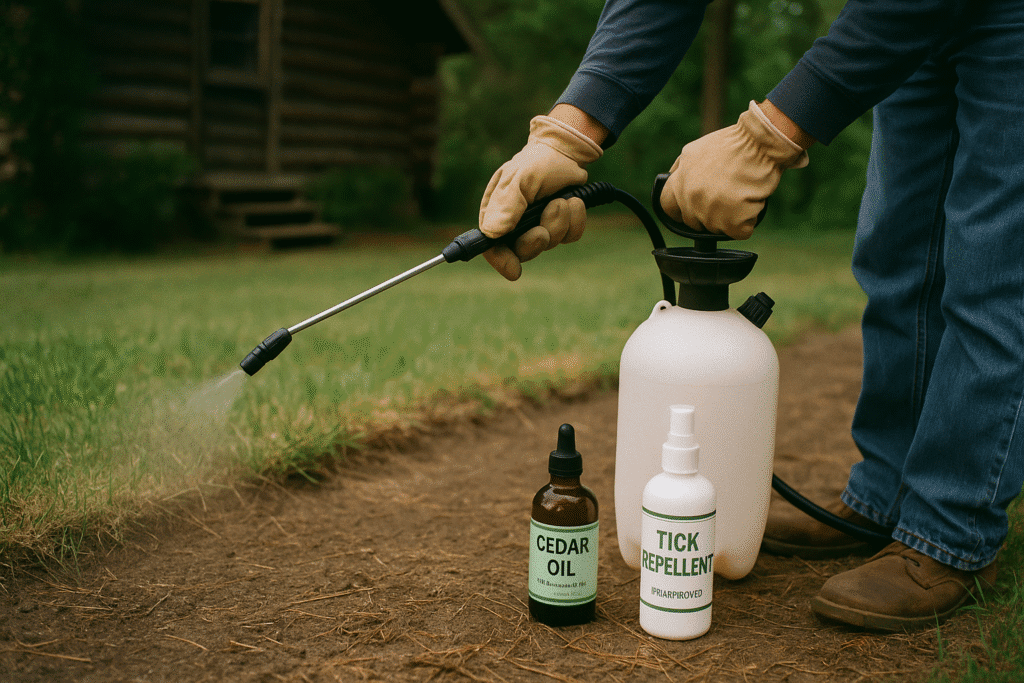
Chemical and natural treatments can help create a protective barrier around your property. Used correctly, these methods can supplement your landscaping and pet care efforts.
Try Natural Repellents Around Your Cabin
If you prefer a non-chemical approach to get rid of ticks around your cottage, several products offer short-term tick deterrence:
- Cedar oil sprays are commonly used on lawns and decks. Safe for pets and children, they act as a mild natural insecticide.
- Diatomaceous earth can be sprinkled in dry areas where ticks may crawl. It dehydrates insects by damaging their outer shell. Use food-grade only and avoid applying during wet weather.
Natural methods tend to be less persistent and may need frequent reapplication—especially in humid or rainy conditions typical in the Upper Midwest.
Be Smart – Use EPA-Approved Insecticides
For more persistent protection, consider targeted use of approved insecticides:
- Permethrin can be used to treat outdoor gear and clothing. It kills ticks on contact but should never be applied directly to skin.
- Bifenthrin or cyfluthrin-based sprays are common for lawn perimeter treatments. Apply only according to label directions and avoid spraying near lakes, rivers, or storm drains.
Avoid blanket-spraying the entire property. Focus on shaded, brushy edges, fence lines, woodpiles, and pet hangouts. Spot applications in high-risk zones are often enough.
For cabins near protected wetlands or waterfronts, contact your local conservation district or DNR office before using any chemical treatments.
Personal Protection Practices

Even with a well-maintained yard and treated pets, it’s still possible to pick up ticks while spending time outdoors. Personal prevention steps canget rid of ticks around your cottage and dramatically reduce your risk of being bitten.
Dress Smart Outdoors
When walking trails, clearing brush, or working in the yard:
- Wear light-colored clothing to make ticks easier to spot.
- Tuck pants into socks and shirts into pants to close gaps.
- Choose long sleeves and pants over shorts and tank tops.
Clothing treated with permethrin—either store-bought or home-treated—can provide long-lasting protection against ticks. These garments are widely available and effective through multiple washings.
Use Effective Repellents
Apply EPA-registered tick repellents before heading outdoors. Look for products with:
- DEET (20–30%)
- Picaridin (20%)
- Oil of lemon eucalyptus (OLE) for a plant-based option
Repellents should be applied to exposed skin, avoiding eyes, mouth, and open wounds. Reapply according to the product label, especially if sweating or in contact with water.
Perform Tick Checks
After spending time outdoors, to get rid of ticks around your cottage, do a full-body tick check. Focus on areas ticks commonly latch onto:
- Behind knees
- Underarms
- Hairline and scalp
- Groin area
- Around the waist
Use a mirror for hard-to-see spots. Ticks often go unnoticed until they’ve been attached for hours, increasing the risk of disease transmission.
Shower soon after coming indoors, and wash clothes in hot water. Ticks can survive cold or lukewarm water, but a full dryer cycle on high heat will kill them.
When to Hire a Professional
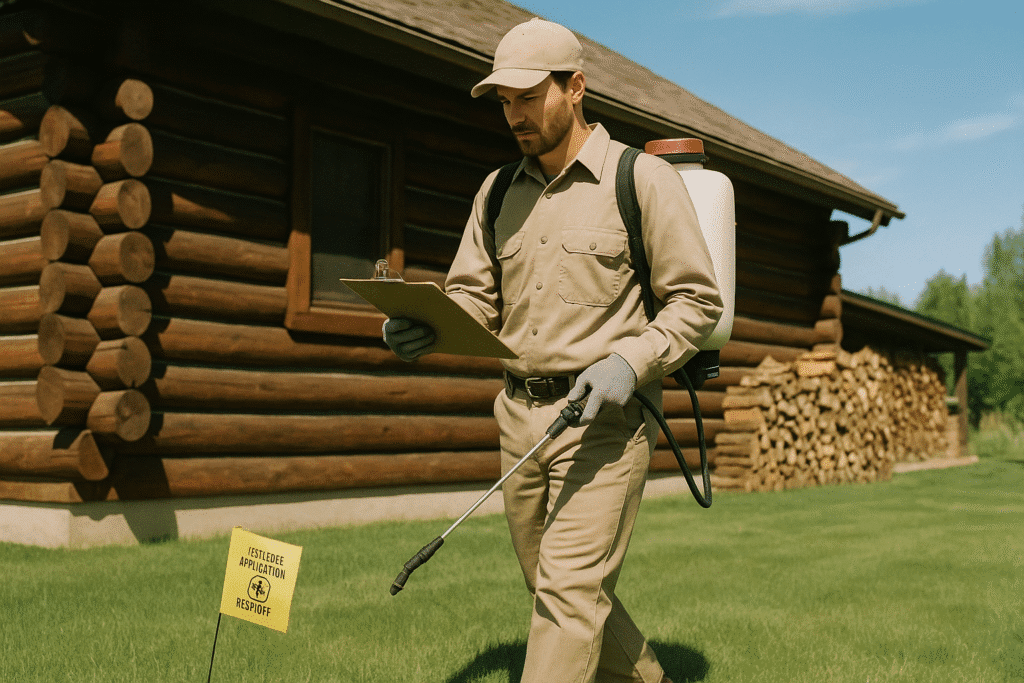
If you’re still finding ticks despite taking precautions, it may be time to bring in a licensed pest control service.
Signs You May Need Help
- Frequent tick bites on pets or people
- Tick sightings near patios, decks, or play areas
- Rodent activity or burrows near the cottage
- Surrounding properties are unmanaged or wooded
Professional tick control services offer targeted yard treatments with longer-lasting formulas. Some companies provide perimeter spraying, rodent baiting, or barrier treatments for seasonal cottages.
Be sure the company is licensed and familiar with local environmental restrictions, especially near lakes, rivers, and protected wetlands, which are common around cabins in the Upper Midwest.
Monitoring and Maintenance
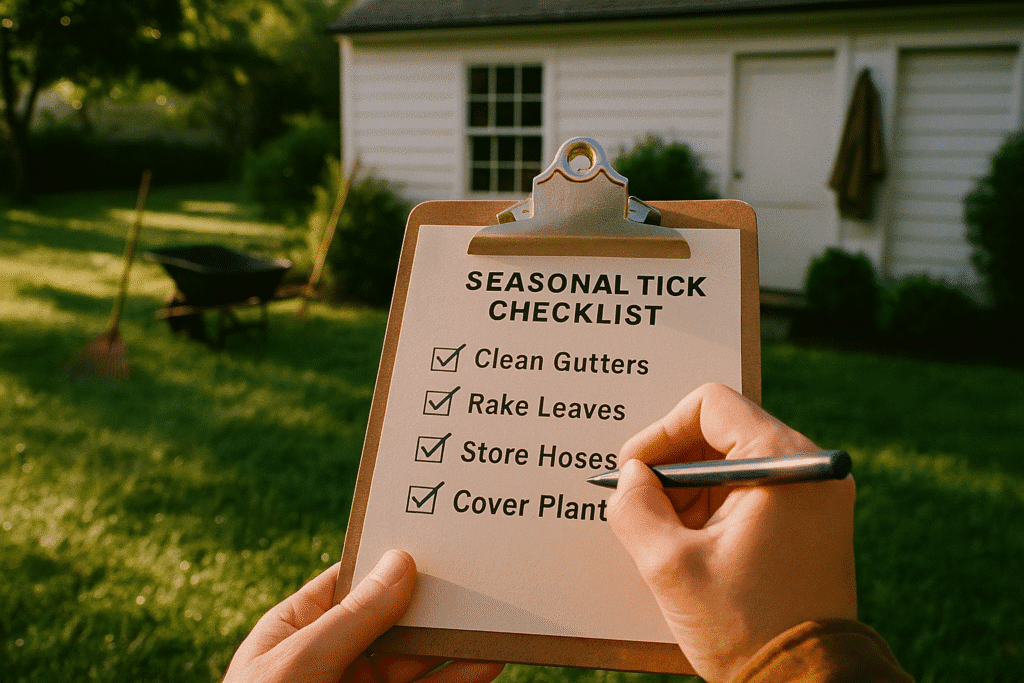
To get rid of ticks around your cottage , tick prevention isn’t a one-time fix—it’s a seasonal responsibility. Once you’ve reduced the tick population, it takes consistent upkeep to keep them from returning. Download our free Tick Prevention Task Checklist for Your Cottage or Cabin.
Tick Prevention Checklist
Ongoing Tasks to Stay Ahead of Ticks:
- Mow the lawn weekly during the growing season.
- Reapply natural repellents every 2–3 weeks or after heavy rainfall.
- Check pets for ticks daily, especially after hikes or playtime in brush.
- Walk the perimeter of your property monthly to check for new rodent nests, overgrown edges, or deer tracks.
- Store clothing and outdoor gear inside if not in use—ticks can survive in shaded, undisturbed spaces like camp chairs and life jackets.
Keep a tick removal kit on hand at your cottage. Include tweezers, antiseptic, a small mirror, and sealable bags for storing removed ticks in case testing is needed.
Yes…Get Rid of Ticks Around Your Cottage
Getting rid of ticks around your cottage or cabin requires a mix of smart landscaping, responsible pet care, personal protection, and—when needed—professional help. Residents of Michigan, Wisconsin, and Minnesota face growing tick risks each year, but that doesn’t mean you have to surrender your summer.
By staying vigilant and consistent, you can make your yard less inviting to ticks and more enjoyable for everyone else. Whether you’re in the woods of the U.P., the lakes of central Minnesota, or the hills of southwest Wisconsin, the steps are the same—and they work.
Sources For Further Reading
- Centers for Disease Control and Prevention. “Where Ticks Live.” Centers for Disease Control and Prevention, May 2025, https://www.cdc.gov/ticks/about/where-ticks-live.html.
- Centers for Disease Control and Prevention. “Preventing Tick Bites.” Centers for Disease Control and Prevention, 9 Apr. 2025, https://www.cdc.gov/ticks/prevention/index.html.
- Michigan Department of Health and Human Services. “Ticks.” Michigan.gov, accessed 18 June 2025, https://www.michigan.gov/mdhhs/safety-injury-prev/environmental-health/topics/mitracking/ticks.
- Minnesota Department of Health. “Tickborne Diseases.” Minnesota Department of Health, May 2024, https://www.health.state.mn.us/diseases/tickborne/index.html.
- Wisconsin Department of Health Services. “Illnesses Spread by Ticks.” Wisconsin DHS, accessed June 2025, https://www.dhs.wisconsin.gov/tick/index.htm.
- Environmental Protection Agency. “Repellents: Protection against Mosquitoes, Ticks and Other Arthropods.” EPA.gov, 18 Apr. 2025, https://www.epa.gov/insect-repellents.
- University of Wisconsin–Madison Extension. “Spring Is Tick Season in Wisconsin.” UW–Madison Division of Extension, 25 May 2024, https://hort.extension.wisc.edu/2024/05/25/spring-is-tick-season-in-wisconsin/.
- Wisconsin Department of Health Services. “Fight the Bite!” Wisconsin DHS, accessed June 2025, https://www.dhs.wisconsin.gov/fight-bite/index.htm.
- Centers for Disease Control and Prevention. “Preventing Tick‑borne Encephalitis.” CDC, May 2024, https://www.cdc.gov/tick-borne-encephalitis/prevention/index.html.
